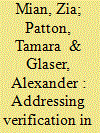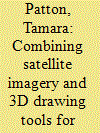|
|
|
Sort Order |
|
|
|
Items / Page
|
|
|
|
|
|
|
| Srl | Item |
| 1 |
ID:
154196


|
|
|
|
|
| Summary/Abstract |
The UN General Assembly last December called for negotiations this year to produce a "legally binding instrument to prohibit nuclear weapons, leading to their total elimination." The nuclear ban treaty talks will have to engage the issue of confirming compliance by the parties with the specific prohibitions established by such a treaty and, in addition, can establish guiding principles for the process of eliminating nuclear weapons and maintaining the resulting nuclear-weapon-free world.
|
|
|
|
|
|
|
|
|
|
|
|
|
|
|
|
| 2 |
ID:
115972


|
|
|
|
|
| Publication |
2012.
|
| Summary/Abstract |
The ability to extract three-dimensional (3D) data from two-dimensional satellite images provides opportunities to apply novel geospatial techniques to problems relating to nuclear arms control, nonproliferation, and disarmament. This study demonstrates some of these techniques by estimating the plutonium production capacity of the heavy water nuclear reactors at the Khushab complex in Pakistan, where since 1998 Pakistan has produced plutonium for its nuclear arsenal. Three-dimensional analysis is used to assess the viability of using the horizontal cross-sectional area of the Khushab reactors' mechanical draft cooling towers to estimate the thermal capacity of each reactor and set an upper bound for the reactors' abilities to produce plutonium. The horizontal area approach suggests the three completed Khushab reactors have a thermal power of 40-90 MWt each. The results suggest that a horizontal area approach can be used successfully with the Khushab reactors, as well as other low power, research-type reactors employing mechanical draft cooling towers.
|
|
|
|
|
|
|
|
|
|
|
|
|
|
|
|
| 3 |
ID:
169456


|
|
|
|
|
| Summary/Abstract |
Researchers have recently proposed a new approach to nuclear-arms-control verification, dubbed “deferred verification.” The concept forgoes inspections at sensitive nuclear sites and of nuclear weapons or components in classified form. To implement this concept, a state first divides its nuclear program into a closed segment and an open segment. The total fissile-material inventory in the closed segment, which includes the weapon complex, is known and declared with very high accuracy. Essentially no inspections take place in the closed segment. In contrast, inspectors have access to the open segment, which includes in particular the civilian nuclear sector. The fissile-material inventory in the open segment is known with less accuracy, but uncertainties can be reduced over time using nuclear-archaeology methods. Deferred verification relies primarily on established safeguards techniques and avoids many unresolved verification challenges, such as the need for information barriers for warhead confirmation measurements. At the same time, deferred verification faces some unique challenges. Here, we explore some of these challenges and offer possible solutions; to do so, we examine possible noncompliance strategies in which a state would seek to withhold a higher-than-declared inventory.
|
|
|
|
|
|
|
|
|
|
|
|
|
|
|
|
| 4 |
ID:
161334


|
|
|
|
|
| Summary/Abstract |
The Treaty on the Prohibition of Nuclear Weapons calls for states to meet regularly to consider measures for the verified, time-bound and irreversible elimination of nuclear weapon programs. Key to this effort is mapping a comprehensive set of nuclear weapon program indicators and further developing international capacity to monitor them. Distinct from the deadlocked Conference on Disarmament, this new forum will have an opportunity to examine and elaborate disarmament verification concepts. One relevant concept is an international monitoring system for nuclear disarmament and nonproliferation verification (NDN-IMS), elaborated from a proposal most recently noted by the United Nations Open-ended Working Group (A/71/371). As a flexible framework, an NDN-IMS, could help unite diverse technologies and mechanisms around the purpose of disarmament verification in ways that support the existing nonproliferation regime and the Nuclear Nonproliferation Treaty. Elements could include satellite imagery from new constellations, wide area environmental sampling, and civil society reporting.
|
|
|
|
|
|
|
|
|
|
|
|
|
|
|
|
|
|
|
|
|